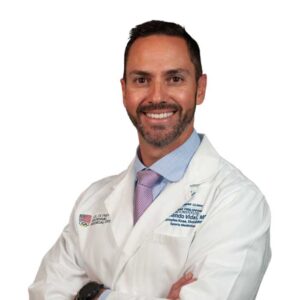What is shoulder instability in children?
The shoulder joint is one of the most flexible joints in the human body. However, its large functional range of motion makes it inherently unstable. Shoulder instability in children is a well-recognized problem which includes traumatic dislocations and recurrent multidirectional instability (MDI). Dr. Armando Vidal, Orthopedic Pediatric Sports Medicine Specialist has extensive experience in treating young patients with shoulder instability. Patients in Vail, Aspen and the surrounding Denver, Colorado communities trust him to help their children who have recurrent dislocations and shoulder instability.

How common is shoulder instability in children?
Nearly 50% of all shoulder dislocations in the United States occur in patients between the ages of 15 and 29. Children under the age of 10 have far less traumatic dislocations, accounting for less than 2%. Although this is a rare occurrence at a very young age, studies have found that young patients have a higher rate of recurrence in both traumatic and nontraumatic shoulder dislocations. In fact, 80% of children under the age of 18 will have recurrent shoulder instability after a dislocation and run a high risk for recurrent dislocations. For this reason, appropriate treatment by Dr. Armando Vidal is very important to reduce the risk of recurrence.
How is shoulder instability different in adolescents?
Children and adolescents are not just “small adults” and cannot be treated as such. Their injuries, treatments and outcome will be different, for example:
- Patients who are not skeletally mature are more likely to have a proximal humeral fracture (upper part of the long bone in the arm) than a dislocation. Treatment for this fracture in children is often non-surgical to prevent damage to the physis (growth plate.)
- In cases of dislocation, children should be x-rayed before the shoulder is reduced (put back in place) so the physis can be evaluated for damage.
- Surgery for continued shoulder instability is often delayed until the child is skeletally mature.
What causes shoulder instability in young athletes?
The end of the humeral head (upper arm’s long bone) attaches to the glenoid (shoulder socket) with three ligaments. These ligaments tighten with different arm positions to hold the shoulder securely within the joint. When these ligaments are stretched or torn, dislocation and shoulder instability can occur. Reasons other shoulder dislocations can occur:
- If there is a problem with the rotator cuff, which are the muscles and tendons that wrap around the shoulder and hold the bones in place.
- Genetic abnormalities or problems with the bones of the shoulder can lead to dislocations.
- Anterior or forward dislocations can occur if your child’s arm is hit when his shoulder is abducted (lifted) and rotated outward (picture a linebacker in football in blocking position.)
- Posterior or backward dislocation can occur from a fall on an outstretched hand, or from a direct tackle or blow to the front of the shoulder.
What are the symptoms of an unstable shoulder?
In most cases involving children, the shoulder will be unstable after a dislocation, rather it be partial or full. Symptoms of shoulder instability may include:
- Chronic pain that worsens with reaching or lifting overhead
- Popping, grinding or catching sensation when moving the shoulder
- Limited range of motion
- Muscle weakness in the affected side
- Tingling or numbness in the arm and fingers
- Shoulder tenderness when palpated
What are the treatment options for children with shoulder instability?
Dr. Vidal prefers a conservative approach when treating children suffering from shoulder instability. He will advise rest, anti-inflammatory medication and, in cases of a dislocation, may put the child in a sling for a period of time to immobilize the joint.
For patients in Vail, Aspen and the surrounding Denver, Colorado communities, physical therapy is often part of the non-surgical treatment. Patients will do exercises to strengthen the muscles around the shoulder, to help stabilize the joint.
Surgical Treatment:
If non-surgical attempts to strengthen the joint and prevent further dislocations fail, surgery may be necessary. The goal of shoulder surgery in children is to repair the labrum and tighten the ligaments of the shoulder joint, giving the humerus less room to move. This can often be done arthroscopically using a small surgical camera and small specialized instruments to operate within the joint.
When considering surgical intervention for your child’s shoulder instability, it is important to seek a provider who has extensive experience in pediatric orthopedic shoulder surgery. Dr. Armando Vidal can provide patients with options and has a proven track record for helping adolescents with shoulder instability.
Pediatric Shoulder Instability Surgeon
Did your child experience a shoulder dislocation, or other traumatic shoulder injury? If so, there is a chance your child may experience lingering shoulder instability. This condition can cause your child to feel weak in the affected arm, have a decreased range of motion, or feel popping during movement. Pediatric shoulder surgeon, Doctor Armando Vidal provides diagnosis as well as arthroscopic stabilization surgery for young patients in Vail, Aspen, and the surrounding Denver, Colorado communities who are experiencing shoulder instability. Contact Dr. Vidal’s team today!

Locations
180 S Frontage Rd W
Vail, CO 81657
226 Lusher Court
Ste 101
Frisco, CO 80443
322 Beard Creek Road
Edwards, CO 81632


